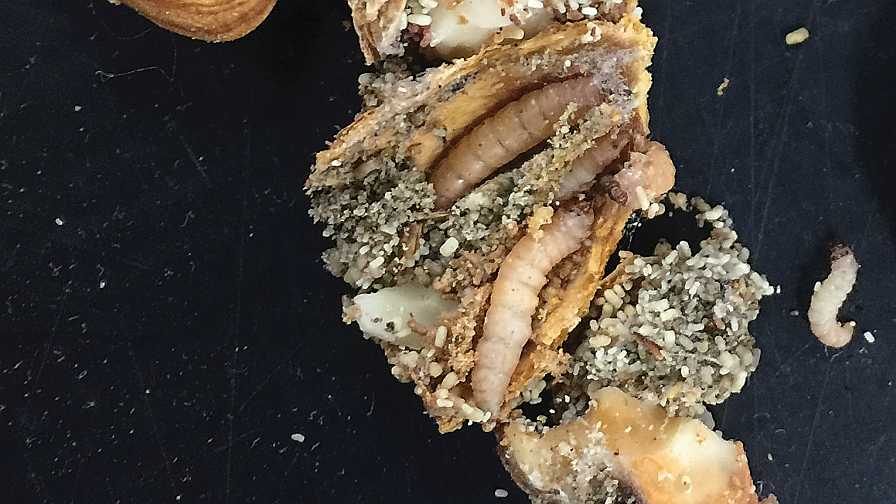Almond Growers Should Take a New Look at Bts

Navel orangeworm (NOW) is Enemy No. 1, the most destructive pest of almonds, which it can be seen damaging here.
Photo by Jhalendra Rijal
Just because a product is old does not mean it’s no longer a fit. University of California (UC) Cooperative Extension IPM Advisor Jhalendra Rijal thinks Bacillus thuringiensis (Bt) can play an important role in controlling peach twig borer (PTB) and navel orangeworm (NOW) in almonds by integrating this product into a pest management program.
Rijal will be a speaker at our BiocontrolsSM USA West Conference and Expo. Visit BiocontrolsConference.com/USA-West/ to register.
Regulators, buyers, consumers: All are clamoring for softer products, a fit for Bts.
“Bts have very low impact to both workers and the environment, to beneficial insects, bees, and other natural enemies,” he says. “It’s definitely a fit for organic, but also conventional as well.”
UC IPM guidelines have Bacillus thuringiensis subspecies kurstaki, as one of the insecticides listed to control NOW and PTB in almonds. Bt is a spore-forming bacterium species that produces protein crystals that are toxic to insects.
Rijal is quick to point out Bts perform differently than conventional insecticides. The Bt toxin is ingested by the pest and affects its intestines. The crystal protein toxin binds the gut of the insect, causing cell walls to break down. Bt spores then multiply in the insect’s body, and slowly the larva will die. It may take the pests a few days to die, but the important thing is they stop feeding right away.
An Instructive History Lesson
Decades ago, food safety concerns led the Almond Board of California (ABC) to sponsor studies on how to control growers’ insect nemesis, NOW (Amyelois transitella), with Bt applications. The ABC wanted to make sure growers had a sustainable alternative in the event chemical controls became unavailable.
A study in the mid-1990s led by UCCE Advisor Joe Connell indicated that when worm damage levels were relatively low (<5% damage), Bt applications at 1% hull split timing were as good as any spray alternative, no matter how harsh. None of the currently used insecticides can solely control NOW, but Rijal notes that performing the most basic sanitation procedures — removing and destroying any mummy nuts left in the orchard after harvest — is the foundation of NOW control.
Today, some of those older chemical controls, such as organophosphates, haven’t necessarily become unavailable, as was feared, but there are certainly numerous barriers to use. Growers have gone to softer insecticides to control worm pests, namely Altacor and Intrepid, but that’s about all that’s available. Except for pyrethroids, that is, but they are too rough on beneficials such as mite predators and this may lead to spraying more for mites later in the season.
Bts and IPM
Rijal says there are three main benefits to Bts: No preharvest interval to follow, no harmful residues on fruits, and kindness to beneficial insects. Because of these reasons, Bt is a good fit for an IPM program.
As mentioned above, the only truly soft chemical insecticides growers have for NOW control are Altacor and Intrepid, raising resistance concerns. In general, the more growers can avoid using just a couple insecticides, particularly in large amounts, the more years the insecticides will remain effective.
For another common worm pest, PTB, growers can spray Bts during bloom time, a huge advantage because they don’t harm bees. Bt is the only insecticide that UC IPM Guidelines suggest using if there is a need for PTB control during bloom. PTB larvae overwinter inside a cocoon (called hibernacula) in tree crotches. As temperatures become favorable, these young larvae emerge from the hibernacula and move toward the tops of the trees and spraying Bt during that time kills the larvae after they ingest the Bt product.
Rijal says two applications during bloom time are generally enough to control PTB, the first application when 20% to 40% of the PTB larvae have emerged from the cocoon, and the second application seven to 10 days later. If the emergence is spread out, a third spray may be needed due to the relatively short time that Bt residues are present after application. As a bonus, they are a great fit with fungicides sprayed at bloom.
Overall, growers catch a bit of relief with Bts because they need not be concerned about a lot of factors that come into play with other products for controlling PTB during bloom time, Rijal says.
“With Bts you don’t need to worry about pesticide residues, groundwater contamination, none of that,” he says.
However, application technique is critical. Because Bts target the larval stages and must be ingested, spray coverage is very important. The materials must be on the plant surface so when the larva crawls across it will ingest the toxin.
Growers should go slowly, as in this case speed doesn’t kill. Make sure your sprayer is calibrated, and keep up a high volume of spray — wetter is better. The good news is that Bts generally come in wettable powder form, and are pretty compatible with tank mixes.
Bt affects only the larval stage of the insect. Target larvae when they are very small, when eggs are about to hatch or when larvae are very young. During the hull split timing, it takes about three to five days for a NOW egg to become larva depending on the temperature and geographic location. External environmental factors such as temperature and sunlight may reduce the efficacy of Bt.
“It’s not a huge window,” Rijal says, “so you must be on the ball, as growers do for many products.”









